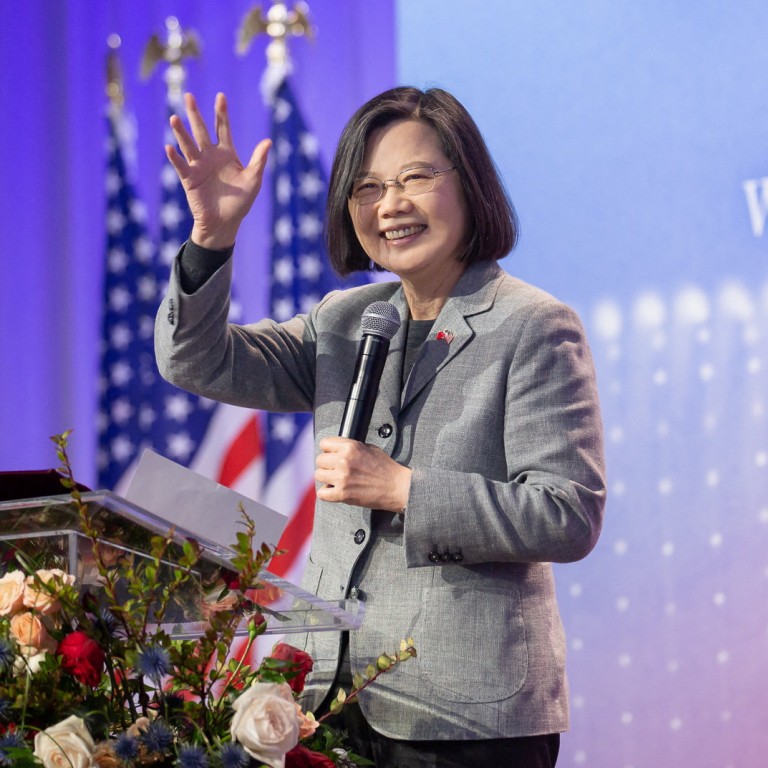
Taiwanese leaders’ duelling trips offer lessons in an age of great power struggle
- The timing seemed like a choreographed play to reach out to two competing powers whose interaction has a huge impact on the island’s fortunes
- Former leader Ma Ying-jeou’s historic mainland visit could temper Beijing’s response to Tsai Ing-wen’s crucial US stopovers
Tsai and Ma come from the two dominant parties in Taiwanese politics, which represent diverging views on how to chart the self-ruled island’s future. Their duelling visits are likely to sharpen the political divide in the run-up to elections early next year, and be parsed for signals given rising cross-strait tensions and the role Taiwan plays in global technology supply chains.
The timing seemed like a choreographed play to reach out to two competing powers whose interaction has a huge impact on the island’s fortunes. Taiwan’s first female president crossed the Pacific on Wednesday for a 10-day trip to four cities in the Americas, while veteran leader Ma began a 12-day tour of five mainland Chinese cities on Tuesday.
Many consider Tsai’s trips to Guatemala and Belize mere sideshows to her US layovers. But Washington was not on Tsai’s itinerary, nor was Beijing on Ma’s. Taipei played down Tsai’s US transits as routine, while Ma’s camp tried to depoliticise his visit, stressing its private nature.

Ma, in turn, looked likely to eschew high-level meetings with mainland officials to dispel political connotations. Instead, he made a pitch for continued economic and people-to-people ties, hence the student delegation he brought along with him.
Such coordination – whether deliberate or by chance – creates space for Tsai in her discussions with the US, recognising the cushion that Ma’s travel can provide. Hence, noise aside, there seems to be much underlying logic to the two leaders’ duelling visits.
The politics of Taiwan’s Ma Ying-jeou referencing ‘yan huang descendants’
Tsai’s stops in New York and Los Angeles reinforce America’s importance for Taiwan, a role that is bound to grow as pressure from Beijing intensifies. As the island’s formal diplomatic allies dwindle, it is likely to invest more in the quality of unofficial ties it has with key countries, and the US tops that list.
Washington can rally countries, especially European and Asian allies, to bolster support for the self-governing island. For instance, two days before Taipei severed ties with Honduras, a 150-strong parliamentary delegation from the Czech Republic headed by Lower House Speaker Markéta Pekarová Adamová arrived in Taiwan. Such displays of solidarity are expected to increase with lawmakers and ministers, mostly from Western nations, lining up to visit.
Taiwan is garnering more sympathy for its plight and is appealing to important state branches. Foreign legislatures can compel their governments to keep support for the democratic island even if it entails friction with Beijing. Of course, normalised official visits from the West to offset lost diplomatic allies are not sustainable trade-offs in the long run. But Taipei will not take the erosion of its international profile lightly and will fight for any opening to keep its visibility.
That said, it is critical for Taiwan to retain its remaining official allies, both to sustain diplomatic recognition and for strategic reasons. Allies in Central America and the Caribbean, for instance, provide cover for US stops. While Washington was unable to prevent Honduras from switching sides, it will likely work to prevent another repeat among Taiwan’s remaining 13 allies, especially those in the Western Hemisphere and among Pacific island nations. Elections in these remaining holdouts may thus become tight contests for keeping or losing them to Beijing. The US may also lead calls for Taiwan’s meaningful participation in relevant international organisations.
If security trumps economics, further pressure may only push the island deeper into America’s embrace
‘I have waited 36 years’: Taiwanese ex-president Ma on historic cross-strait trip
Efforts by Taiwan to reshore or offshore production away from the mainland to enhance supply chain resilience will entail great costs, take time and raise the prices of semiconductors in the near term, with domino effects being felt on the growing number of goods that use chips.
Sure, Southeast Asian countries can offer proximate and competitive places to relocate and will be more than happy to welcome Taiwanese investments, but the mainland’s market is difficult to replace. Besides, dispersing production – especially of advanced chips – may only serve to diminish Taiwan’s strategic value, which made the international community so invested in its security to begin with. Opportunity costs, the further loss of diplomatic allies, and heightened risks of war make the visits – controversy and all – worth the gamble.
By a stroke of serendipity, Tsai and Ma may be able to get their messages across to Beijing and Washington and offer lessons for others wanting to thrive in the age of great power struggle.
Because for Asia, as Winston Churchill once said, jaw-jaw is better than war-war.

